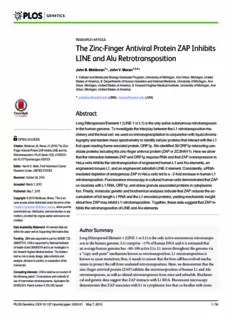Table Of ContentRESEARCHARTICLE
The Zinc-Finger Antiviral Protein ZAP Inhibits
LINE and Alu Retrotransposition
JohnB.Moldovan1*,JohnV.Moran1,2,3*
1 CellularandMolecularBiologyGraduateProgram,UniversityofMichigan,AnnArbor,Michigan,United
StatesofAmerica,2 DepartmentsofHumanGeneticsandInternalMedicine,UniversityofMichigan,Ann
Arbor,Michigan,UnitedStatesofAmerica,3 HowardHughesMedicalInstitute,UniversityofMichigan,Ann
Arbor,Michigan,UnitedStatesofAmerica
* [email protected](JBM); [email protected](JVM)
Abstract
LongINterspersedElement-1(LINE-1orL1)istheonlyactiveautonomousretrotransposon
inthehumangenome.ToinvestigatetheinterplaybetweentheL1retrotranspositionma-
chineryandthehostcell,weusedco-immunoprecipitationinconjunctionwithliquidchroma-
OPENACCESS
tographyandtandemmassspectrometrytoidentifycellularproteinsthatinteractwiththeL1
Citation:MoldovanJB,MoranJV(2015)TheZinc- firstopenreadingframe-encodedprotein,ORF1p.Weidentified39ORF1p-interactingcan-
FingerAntiviralProteinZAPInhibitsLINEandAlu didateproteinsincludingthezinc-fingerantiviralprotein(ZAPorZC3HAV1).Hereweshow
Retrotransposition.PLoSGenet11(5):e1005121.
thattheinteractionbetweenZAPandORF1prequiresRNAandthatZAPoverexpressionin
doi:10.1371/journal.pgen.1005121
HeLacellsinhibitstheretrotranspositionofengineeredhumanL1andAluelements,an
Editor:HarmitS.Malik,FredHutchinsonCancer
engineeredmouseL1,andanengineeredzebrafishLINE-2element.Consistently,siRNA-
ResearchCenter,UNITEDSTATES
mediateddepletionofendogenousZAPinHeLacellsledtoa~2-foldincreaseinhumanL1
Received:October24,2014
retrotransposition.FluorescencemicroscopyinculturedhumancellsdemonstratedthatZAP
Accepted:March3,2015 co-localizeswithL1RNA,ORF1p,andstressgranuleassociatedproteinsincytoplasmic
Published:May7,2015 foci.Finally,moleculargeneticandbiochemicalanalysesindicatethatZAPreducestheac-
cumulationoffull-lengthL1RNAandtheL1-encodedproteins,yieldingmechanisticinsight
Copyright:©2015Moldovan,Moran.Thisisan
openaccessarticledistributedunderthetermsofthe abouthowZAPmayinhibitL1retrotransposition.Together,thesedatasuggestthatZAPin-
CreativeCommonsAttributionLicense,whichpermits hibitstheretrotranspositionofLINEandAluelements.
unrestricteduse,distribution,andreproductioninany
medium,providedtheoriginalauthorandsourceare
credited.
DataAvailabilityStatement:Allrelevantdataare
AuthorSummary
withinthepaperanditsSupportingInformationfiles.
Funding:JBMwassupportedinpartbyNIGMST32 LongINterspersedElement-1(LINE-1orL1)istheonlyactiveautonomousretrotranspo-
GM007315.JVMissupportedbyNationalInstitutes soninthehumangenome.L1scomprise~17%ofhumanDNAanditisestimatedthat
ofHealthGrantGM060518andisaninvestigatorin anaveragehumangenomehas~80–100activeL1s.L1movesthroughoutthegenomevia
theHowardHughesMedicalInstitute.Thefunders a“copy-and-paste”mechanismknownasretrotransposition.L1retrotranspositionis
hadnoroleinstudydesign,datacollectionand
knowntocausemutations;thus,itstandstoreasonthatthehostcellhasevolvedmecha-
analysis,decisiontopublish,orpreparationofthe
nismstoprotectthecellfromunabatedretrotransposition.Here,wedemonstratethatthe
manuscript.
zinc-fingerantiviralprotein(ZAP)inhibitstheretrotranspositionofhumanL1andAlu
CompetingInterests:JVMislistedasaninventorof
retrotransposons,aswellasrelatedretrotransposonsfrommiceandzebrafish.Biochemi-
thefollowingpatent:“Compositionsandmethodsof
calandgeneticdatasuggestthatZAPinteractswithL1RNA.Fluorescentmicroscopy
useofmammalianretrotransposons.ApplicationNo.
60/006,831;Patentnumber6,150,160;Issued demonstratesthatZAPassociateswithL1incytoplasmicfocithatco-localizewithstress
PLOSGenetics|DOI:10.1371/journal.pgen.1005121 May7,2015 1/34
ZAPInhibitsLINE-1andAluRetrotransposition
November21,2000.”JVMhasreceivednomoney
fromthepatentandthepatentdoesnotinfluenceany granuleproteins.MechanisticanalysessuggestthatZAPreducestheexpressionoffull-
oftheresults/interpretationsinthepaper.This lengthL1RNAandtheL1-encodedproteins,therebyprovidingmechanisticinsightfor
informationshouldnotrepresentaconflictofinterest
howZAPmayrestrictsretrotransposition.Importantly,thesedatasuggestthatZAPini-
andisbeingdisclosedvoluntarily.
tiallymayhaveevolvedtocombatendogenousretrotransposonsandsubsequentlywasco-
optedasaviralrestrictionfactor.
Introduction
LongINterspersedElement-1(LINE-1,alsoknownasL1)sequencescomprise~17%ofhuman
DNAandrepresenttheonlyclassofautonomouslyactiveretrotransposonsinthegenome[1].
L1smobilize(i.e.,retrotranspose)throughoutthegenomeviaanRNAintermediatebyacopy-
and-pastemechanismknownasretrotransposition[reviewedin2].Theoverwhelmingmajori-
tyofhumanL1sareretrotransposition-deficientbecausetheyare5'truncated,containinternal
rearrangements(i.e.,inversion/deletionevents),orharborpointmutationsthatcompromise
thefunctionsoftheL1-encodedproteins(ORF1pandORF2p)[1,3].Despitethesefacts,itises-
timatedthattheaveragediploidhumangenomecontains~80–100L1elementsthatarecapable
ofretrotransposition[4–6].ItisestimatedthatanewL1insertionoccursinapproximately1
outof200livehumanbirths[reviewedin7].Onoccasion,L1retrotranspositioneventscandis-
ruptgeneexpression,leadingtodiseasessuchashemophiliaA[8],Duchennemusculardystro-
phy[9],andcancer[10,11].Indeed,L1-mediatedretrotranspositioneventsareresponsiblefor
atleast96disease-producinginsertionsinman[reviewedin12].
Afull-lengthhumanL1is~6kbinlengthandencodesa5'UTRthatharborsaninternal
RNApolymeraseIIpromoterthatdirectstranscriptionfromatornearthefirstbaseoftheele-
ment[13–15].The5'UTRisfollowedbytwoopenreadingframes(ORFs)thatareseparated
byashort63bpinter-ORFspacer,anda3'UTRthatendsinavariablelengthpolyadenosine
(poly(A))tract[16,17].ThefirstL1ORFencodesan~40kDaprotein(ORF1p)thathasnucleic
acidbinding[18–22]andnucleicacidchaperoneactivities[22,23].ThesecondL1ORFen-
codesamuchlarger~150kDaprotein(ORF2p)[24–26],whichexhibitssingle-strandendonu-
clease(EN)[27]andreversetranscriptase(RT)[28,29]activities.Experimentsinculturedcells
haverevealedthatactivitiesassociatedwithbothORF1pandORF2parerequiredforefficient
L1retrotransposition[27,30].
DuringacycleofL1retrotransposition,afull-lengthL1istranscribedandtheresultantbicis-
tronicL1mRNAisexportedtothecytoplasmwhereitundergoestranslation.Notably,L1RNA
istranslatedinacap-dependentmannerbyanunconventionaltermination-reinitiation
mechanismthatfacilitatestranslationofbothL1ORFs[31–34].Followingtranslation,
ORF1pandORF2ppreferentiallybindtotheirrespectiveencodingL1mRNAtemplate(aphe-
nomenonknownascis-preference[35,36])toformanL1ribonucleoproteinparticle(RNP)
[18,19,26,37,38].ComponentsoftheL1RNPgainaccesstothenucleusbyaprocessthatdoes
notstrictlyrequirecelldivision[39],althoughL1retrotranspositionseemstobeenhancedindi-
vidingcells[40,41].OncetheL1RNPhasenteredthenucleus,theL1RNAisreversetranscribed
andinsertedintogenomicDNAbyaprocessknownastarget-siteprimedreversetranscription
(TPRT)[27,42,43].Briefly,theORF2pendonucleasegeneratesasingle-strandendonucleolytic
nickingenomicDNAatathymidinerichconsensussequence(e.g.,5'-TTTT/A,5'-TCTT/A,
5'-TTTA/A,etc.)[27,44,45].Theresulting3'hydroxylgroupthenisusedbytheORF2preverse
transcriptaseasaprimertoinitiate(-)strandL1cDNAsynthesisfromtheL1mRNAtemplate
[27,44].ThecompletionofL1integrationrequireselucidation,butlikelyinvolveshostproteins
involvedinDNArepairand/orreplication[45–48].Notably,theL1-encodedproteinsalsocan
PLOSGenetics|DOI:10.1371/journal.pgen.1005121 May7,2015 2/34
ZAPInhibitsLINE-1andAluRetrotransposition
workintranstoretrotransposeothercellularRNAssuchasShortInterspersedElements
(SINEs)(e.g.,Alu[49]andSINE-R/VNTR/Alu(SVA)elements[50–52]).L1alsocan
mobilizeuracil-richsmallnuclearRNAs(e.g.,U6snRNA[48,53,54],smallnucleolarRNAs(e.g.,
U3snoRNA[55]),andmessengerRNAs,whichresultsintheformationofprocessedpseudo-
genes[35,36]).
SinceL1retrotranspositioncanbemutagenic,itstandstoreasonthatthehostcellemploys
multiplemechanismstorestrictL1mobilization[reviewedin56].Forexample,cytosinemeth-
ylationoftheL15'UTRsuppressesL1expression[57,58].Inaddition,piwi-interactingRNAs
(piRNAs)suppressL1expressioningermlinecells[reviewedin56,59,and60].Finally,emerg-
ingstudieshavedemonstratedthatseveralcellularproteinsrestrictL1retrotransposition.
TheseproteinsincludeseveralAPOBEC3familymembers[61,reviewedin62],TREX1[63],
MOV10[64–66],hnRNPL[67],SAMHD1[68],RNaseL[69],andthemelatoninreceptor1
(MT1)[70].
TogainamorecompleteunderstandingoftheinterplaybetweentheL1retrotransposition
machineryandthehostcell,weusedliquidchromatography-tandemmassspectrometry
(LC-MS/MS)toidentifyproteinsthatco-immunoprecipitatewithL1ORF1pinHeLacells,rea-
soningthatsomeoftheseproteinsmayaffectL1retrotransposition.Wenextanalyzedtheef-
fectsofORF1p-interactingproteinsonL1retrotranspositionbyoverexpressingasubsetof
theminaculturedcellretrotranspositionassay[30,71].Here,wereportthatthezinc-fingeran-
tiviralproteinZAP[72]interactswithL1RNPsandinhibitsL1retrotranspositionincultured
cells.ZAPalsoinhibitshumanAluretrotranspositionandtheretrotranspositionofmouseand
zebrafishLINEelements.MoleculargeneticandbiochemicalanalysessuggestthatZAPinhibits
retrotranspositionbysuppressingtheaccumulationoffull-lengthL1RNAandL1-encoded
proteinsinthecell.
Results
IdentificationofL1ORF1p-interactingproteins
ToidentifyproteinsthatinteractwithL1ORF1p,wetransfectedHeLacellswithahumanL1
construct,pJM101/L1.3FLAG,whichexpressesaversionofORF1pcontainingaFLAGepitope
atitscarboxyl-terminus(ORF1p-FLAG)(Fig1A).ThepJM101/L1.3FLAGconstructexhibits
robustretrotranspositionactivityinHeLacells,albeitatalowerefficiency(~50%)thantheun-
taggedL1construct,pJM101/L1.3(S1AFig).
Briefly,HeLacellsweretransfectedwithpJM101/L1.3FLAGorpJM101/L1.3,asimilarcon-
structthatlackstheFLAGepitopesequence(Fig1A).Wholecelllysatesfromtransfectedcells
thenwereincubatedwithanti-FLAGcoatedagarosebeadstoimmunoprecipitateORF1p-
FLAG(seeMethods).ImmunoprecipitatedfractionswereanalyzedbySDS-PAGEandproteins
werevisualizedbysilverstaining(Fig1B).Theanalysisofsilver-stainedgelsrevealedapromi-
nentbandof~40kDa(thetheoreticalmolecularweightofORF1p)inthepJM101/L1.3FLAG
immunoprecipitationlane(Fig1B;asterisk),whichwasnotapparentinthepJM101/L1.3lane.
WesternblotanalysiswithanantibodyspecifictoL1.3ORF1p(aminoacids31–49)confirmed
theenrichmentofORF1p-FLAGinthepJM101/L1.3FLAGlane(Fig1CandS1BFig;bottom
panel).Wealsoobservedacomplexpatternofbandsbetween~25kDaand~150kDathatwas
presentinthepJM101/L1.3FLAGlanethatwasnotevidentinthepJM101/L1.3lane(Fig1B;
blackverticalbars).Asimilarpatternofproteinbandswasproducedonsilver-stainedgels
frompJM101/L1.3FLAGimmunoprecipitationreactionsusingdifferentwashand/orlysiscon-
ditions(S1BandS1CFig,respectively).
TodeterminetheidentityofcellularproteinsthatassociatedwithORF1p-FLAG,thebands
fromthelanescorrespondingtothepJM101/L1.3FLAGandpJM101/L1.3immunoprecipitation
PLOSGenetics|DOI:10.1371/journal.pgen.1005121 May7,2015 3/34
ZAPInhibitsLINE-1andAluRetrotransposition
Fig1.TheidentificationofhostproteinsimmunoprecipitatedwithL1ORF1p-FLAG.(A)SchematicofL1constructs:pJM101/L1.3expressesahuman
L1(L1.3)[5]containinganmneoIretrotranspositionindicatorcassettewithintheL13'UTR.ThepJM101/L1.3FLAGconstructisidenticaltopJM101/L1.3,but
containsasingleFLAGepitopeonthecarboxyl-terminusofORF1p.BothconstructswereclonedintoapCEP4mammalianexpressionvector.ACMV
promoteraugmentsL1expressionandanSV40polyadenylationsignal(pA)islocateddownstreamofthenativeL1polyadenylationsignal.(B)Resultsof
immunoprecipitationexperiments:WholecelllysatesfromHeLacellstransfectedwitheitherpJM101/L1.3orpJM101/L1.3FLAGweresubjectedto
immunoprecipitationusingananti-FLAGantibody.TheproteinsthenwereseparatedbySDS-PAGE,visualizedbysilverstaining,andsubjectedtoLC-MS/
MS.An~40kDabandcorrespondingtothetheoreticalmolecularweightofORF1pisvisibleinthepJM101/L1.3FLAGlane(*).Blackbarsindicatethe
approximatemolecularweightsoftheORF1p-FLAGinteractingproteins.Molecularweightstandards(kDa)areshownonthelefthandsideofthegel.(C)
ValidationoftheORF1p-FLAGimmunoprecipitation:Westernblotexperimentsusinganantibodyspecifictoaminoacids31–49ofL1.3ORF1pverifiedthe
enrichmentofORF1p-FLAGinpJM101/L1.3FLAG,butnotpJM101/L1.3immunoprecipitationreactions.CellstransfectedwiththepCEP4vectorservedasa
negativecontrol.(D)ValidationofputativeORF1p-FLAGinteractingproteins:WesternblotimagesofthepJM101/L1.3FLAGandpJM101/L1.3
immunoprecipitation(IP)reactions.ThepCEP4lanesdenotewholecelllysatesderivedfromHeLacellstransfectedwithanemptypCEP4vector(~1.0%
input).Primaryantibodiesusedtoprobewesternblotsareindicatedtotheleftoftheimages.Immunoprecipitationreactionswereconductedineitherthe
PLOSGenetics|DOI:10.1371/journal.pgen.1005121 May7,2015 4/34
ZAPInhibitsLINE-1andAluRetrotransposition
absence(left)orpresence(right)ofRNaseA(10μg/mL).TheputativecellularfunctionsoftheORF1p-FLAGinteractingproteinsareindicatedontheright
handsideoftheblots.
doi:10.1371/journal.pgen.1005121.g001
experimentswereexcisedfromSDS-PAGEgelsandsubmittedforLC-MS/MS(seeMethods).
AnLC-MS/MS-identifiedproteinwasselectedasanORF1p-interactingcandidateifitmetthe
followingcriteria:1)theproteinwasuniquetothepJM101/L1.3FLAGimmunoprecipitation,
and2)theproteinwasidentifiedbytwoormoreuniquepeptidesequences(peptideerrorrate
(cid:1)0.05;proteinprobability(cid:3)0.95)(S1TableandMethods).Thirty-nineORF1p-interactingpro-
teincandidateswereidentifiedthatmetthesecriteria(S1Table).
ToconfirmtheinteractionsbetweenLC-MS/MS-identifiedproteinsandORF1p-FLAG,we
evaluated13ofthe39ORF1p-FLAGinteractingproteinsforwhichtherewerecommercially
availableantibodiesand/orcDNAexpressionclones.Westernblotanalysesconfirmedthat
theseproteinsassociatedwithORF1p-FLAG(Fig1D).The13ORF1p-interactingproteinsare
involvedinavarietyofcellularprocessesincludingantiviraldefense(ZAP[72]andMOV10
[73]),nonsense-mediateddecay(UPF1[74]),RNAsplicing(hnRNPL[75]andDHX9
[76,77]),andtranscription(PURA[78],CDK9[79],andILF3[80]).Notably,geneontology
[81]andglobalanalysesofRNAbindingproteinsinhumancelllines[82,83]revealedthatthe
13validatedORF1p-FLAGinteractingproteinsareRNAbindingproteins(RBPs).Consistent-
ly,immunoprecipitationexperimentsofORF1p-FLAGconductedinthepresenceofRNaseA
disruptedtheassociationbetweenORF1pandeachofthe13ORF1p-interactingproteins(Fig
1D).Thus,themajorityofORF1p-interactingproteinsassociatewithORF1pbybindingtoL1
RNAand/orotherRNAspresentwithintheL1RNP[84].
ORF1p-interactingproteinsrestrictL1retrotranspositioninHeLacells
WenextinvestigatedwhetheroverexpressionofnineofthevalidatedORF1p-interactingpro-
teins,aswellasnineunvalidatedORF1p-interactingproteins,affectsL1retrotransposition
[30,71].Briefly,HeLacellswereco-transfectedwithacDNAplasmidexpressingoneofthe
ORF1p-FLAGinteractingproteinsandanengineeredhumanL1construct(pJJ101/L1.3;[85])
markedwithablasticidinretrotranspositionindicatorcassette(mblastI)(Fig2Aand2B;top
panel).ThemblastIcassettecontainsanantisensecopyoftheblasticidindeaminasegene,
whichisclonedintotheL13'UTR.Theblasticidindeaminasegenealsoisinterruptedbyanin-
troninthesametranscriptionalorientationasL1.Thisarrangementensuresthattheblastici-
dindeaminasegeneisexpressedonlywhentheL1transcriptisspliced,reversetranscribed,
andinsertedintogenomicDNA.Theresultingblasticidin-resistantfocithenprovideavisual,
quantitativereadoutofretrotranspositionactivity[30,45].
TomonitorpotentiallytoxicsideeffectsofcDNAoverexpression,HeLacellsalsowereco-
transfectedinaparallelassaywithacDNAexpressionvectorandacontrolplasmid(pcDNA6/
TR)thatexpressestheblasticidindeaminasegene(Fig2B;bottompanel).Followingblasticidin
selection,theresultingfociprovideavisual,quantitativereadoutoftheeffectofcDNAoverex-
pressiononcolonyformation(Fig2B;bottompanel).Thiscontrolisessentialtodetermineifa
cDNAaffectsL1retrotranspositionorcellviabilityand/orgrowth.
Weco-transfectedHeLacellswitheachofthe18ORF1p-FLAGinteractingcandidatesand
pJJ101/L1.3(Fig2C).AnemptypCEP4vectorthatwasco-transfectedwithpJJ101/L1.3served
asanormalizationcontrol(Fig2Band2C).Asanegativecontrol,wedemonstratedthataplas-
midthatexpressesthehumanizedrenillagreenfluorescenceprotein(pCEP/GFP)didnotaffect
pJJ101/L1.3retrotransposition.Asapositivecontrol,wedemonstratedthataplasmidthatex-
presseshumanAPOBEC3A(pK_A3A)reducedpJJ101/L1.3retrotranspositionto~18%of
controllevels(Fig2C),whichisinagreementwithpreviousstudies[61,86–88].Fourofthe
PLOSGenetics|DOI:10.1371/journal.pgen.1005121 May7,2015 5/34
ZAPInhibitsLINE-1andAluRetrotransposition
Fig2.SeveraloftheORF1p-FLAGinteractingproteinsinhibitL1retrotransposition.(A)Schematicofthecultured-cellretrotranspositionassay:HeLa
cellsweretransfectedwithanengineeredhumanL1.3construct(pJJ101/L1.3)markedwithablasticidinindicatorcassette(mblastI).ThepJJ101/L1.3
constructwasclonedintoapCEP4mammalianexpressionvector.ACMVpromoteraugmentsL1expressionandanSV40polyadenylationsignal(pA)is
locateddownstreamofthenativeL1polyadenylationsignal.ThemblastIcassetteisclonedintotheL13'UTRantisensetotheL1andcontainsablasticidin
deaminasegenethatisdisruptedbyanintronintheL1senseorientation.TheblasticidindeaminasegenecanonlybeexpressedwhentheL1transcriptis
spliced,reversetranscribed,andinsertedintogenomicDNA[30,71].(B)SchematicofthepJJ101/L1.3retrotranspositionscreen:Toanalyzetheeffectofthe
ORF1p-FLAGinteractingproteinsonL1retrotransposition,HeLacellswereco-transfectedwithequalamountsofpJJ101/L1.3andacDNAplasmid
expressingoneofthecandidateORF1p-FLAGinteractingproteinsorapCEP4emptyvector.Tocontrolforpotentialoff-targeteffects,HeLacellsalsowere
co-transfectedwithacontrolplasmid(pcDNA6/TR)thatexpressestheblasticidindeaminasegeneandacDNAplasmidexpressingoneofthecandidate
proteinsorapCEP4emptyvector.Bothassaysweresubjectedtothesameblasticidinselectionregimen.Theresultantnumberofblasticidin-resistant
coloniesinpcDNA6/TRcontrolassaysprovidesavisual,quantitativereadoutoftheeffectofcDNAoverexpressionontheabilityofcellstogrowinthe
presenceofblasticidin.(C)ResultsofpJJ101/L1.3retrotranspositionscreen:HeLacellswereco-transfectedwithpJJ101/L1.3andeachoftheindicated
cDNAexpressingplasmids.L1retrotranspositionwasassayedin6-welltissuecultureplates.TheX-axisindicatesthecDNAthatwasco-transfectedwith
PLOSGenetics|DOI:10.1371/journal.pgen.1005121 May7,2015 6/34
ZAPInhibitsLINE-1andAluRetrotransposition
pJJ101/L1.3.ThebracketednumbernexttoeachcDNAindicatesthenumberofindependentexperiments.TheY-axisindicatesL1retrotranspositionactivity
afteraccountingforcDNAtoxicity(seeFig2B).Retrotranspositionactivity(blackbars)isnormalizedtothepCEP4emptyvectorcontrol.Errorbarsrepresent
thestandarddeviationforeachsetofexperiments.Thereddottedlineindicatesa50%inhibitionofretrotranspositionactivity.
doi:10.1371/journal.pgen.1005121.g002
cDNA-expressingplasmidsthatwetested(ZAP-S(ZAPshortisoform),hnRNPL,MOV10,
andPURA)eachreducedpJJ101/L1.3retrotranspositiontolessthan50%ofpCEP4control
levels.Notably,ZAP-S(~30%ofcontrol),hnRNPL(~30%ofcontrol),MOV10(~13%ofcon-
trol),andPURA(~10%ofcontrol)inhibitedretrotranspositiontolevelssimilartothatof
pK_A3A(~18%ofcontrol)(Fig2C).Bycomparison,themajorityofthecDNA-expressing
plasmids(14/18)didnotsignificantlyaffectpJJ101/L1.3retrotranspositionlevels(lessthan
50%inhibitionwhencomparedtopCEP4controllevels)(Fig2C).Thus,thedatasuggestthat
ZAP-S,hnRNPL,MOV10,andPURAinhibitL1retrotranspositioninculturedcells.
ZAPinhibitsL1retrotransposition
Theabovedata(Fig2C)implythatZAP,hnRNPL,MOV10,andPURAmayfunctionashost
factorsthatrestrictL1retrotransposition.Notably,hnRNPL[67],MOV10[64,65],andPURA
[89]previouslywereshowntoinhibitL1retrotransposition.However,theeffectofZAPonL1
retrotranspositionhasnotbeenstudied;thus,wesoughttodeterminehowZAPinhibits
L1retrotransposition.
ZAPisapoly(ADP-ribose)polymerase(PARP)familymember[90]initiallycharacterized
asanantiviralproteinthatinhibitsmurineleukemiavirus(MLV)replicationinculturedrat
cells[72].PreviousstudiesidentifiedtwohumanZAPisoformsthatresultedfromalternative
splicing[90](Fig3A;toppanel).ThelongZAPisoform(ZAP-L)is902aminoacidsinlength
andcontainsanamino-terminusCCCHzinc-fingerdomainandaninactivecarboxyl-terminal
PARP-likedomain[90].TheshortZAPisoform(ZAP-S)is699aminoacidsinlengthand
lacksthecarboxyl-terminalPARP-likedomain[90].TheHA-taggedhumanZAP-Lisoformre-
strictedpJJ101/L1.3retrotranspositionto~40%ofcontrollevels(Fig3A;blackbars)andthe
humanZAP-SisoformrestrictedpJJ101/L1.3retrotranspositionto~30%ofcontrollevels(Figs
2Cand3A;blackbars).Notably,overexpressionofZAP-LorZAP-Sdidnotdramaticallyaffect
theabilityofHeLacellstoformblasticidin-resistantcoloniesinpcDNA6/TRcontrolassays
(Fig3A,whitebars).Westernblotcontrolexperimentsconfirmedtheoverexpressionofectopic
ZAP-LandZAP-Scomparedtountransfectedcontrols~48hourspost-transfection(S2Aand
S2BFig).Thus,ZAPinhibitsL1retrotranspositioninculturedcellsandtheZAP-LPARP-like
domainisnotrequiredforL1restriction.
PutativeZAPorthologsarepresentinseveralspecies[90];thus,wetestedwhetherarat
ZAPcDNA(rZAP)[72],thatisorthologoustohumanZAP-S[72,90]couldrestrictpJJ101/
L1.3retrotransposition.OverexpressionofrZAPefficientlyreducedretrotranspositionto
~40%ofcontrollevels(Fig3A;blackbars).Thus,theabilitytorestrictL1retrotranspositionis
notlimitedtohumanZAP.
TheZAPzinc-fingerdomainisnecessaryandsufficienttoinhibitL1
retrotransposition
TheZAPzinc-fingerdomainbindstoRNAandisrequiredforantiviralactivity[91,92].Toan-
alyzetheroleoftheZAPzinc-fingerdomaininL1restriction,wetestedtheeffectsofatruncat-
edZAP-SmutantthatexpressestheZAPzinc-fingerdomain(ZAP-S/1-311;containingamino
acids1–311)aswellasaZAP-Smutantthatlacksthezinc-fingerdomain(ZAP-S/Δ72–372;
lackingaminoacids72–372)inpJJ101/L1.3retrotranspositionassays(Fig3A;abovegraph).
PLOSGenetics|DOI:10.1371/journal.pgen.1005121 May7,2015 7/34
ZAPInhibitsLINE-1andAluRetrotransposition
Fig3.ZAP-SinhibitsLINEandAluretrotransposition.(A)ZAPinhibitsL1retrotransposition:Toppanel:SchematicsofZAPconstructs.Depictedarethe
relativepositionsofthezinc-fingerdomains(lightgrayrectangles),cysteine-histidine(CCCH)zinc-fingers(verticalblackbars),andPARP-likedomain(dark
grayrectangles)oftheZAP-LandZAP-Sexpressionconstructs.ZAP-Lcontainsacarboxyl-terminalHAtag(bluerectanglelabeledHA).TheZAP-S/1-311
constructcontainsanadditional31aminoacidsatthecarboxylterminus.TheZAP-S/Δ72–372harborsadeletionthatremovestheCCCHzincfingers(See
Methods).Middlepanel:Resultsoftheretrotranspositionassays.TheX-axisindicatesthecDNAco-transfectedwithpJJ101/L1.3orpcDNA6/TR.TheY-axis
indicatespJJ101/L1.3retrotranspositionactivity(blackbars),orpcDNA6/TRcolonyformationactivity(whitebars).Allvalueshavebeennormalizedtothe
PLOSGenetics|DOI:10.1371/journal.pgen.1005121 May7,2015 8/34
ZAPInhibitsLINE-1andAluRetrotransposition
pCEP4emptyvectorcontrol(100%).ThenumbersabovethebargraphsindicatethenumberofindependentexperimentsperformedwitheachcDNA
expressionconstruct.Errorbarsrepresentstandarddeviations.Bottompanel:Asinglewellofarepresentativesix-welltissuecultureplate,displaying
blasticidin-resistantcoloniesfromthepJJ101/L1.3retrotranspositionassay(top,blackrectangle)andthepcDNA6/TRcontrolassay(bottom,white
rectangle).(B)ZAPinhibitsAluretrotransposition:TheX-axisindicatesthecDNAco-transfectedwithpJM101/L1.3ΔneoandpAluneoTet.TheY-axis
indicatestheretrotranspositionefficiency.AllvaluesarenormalizedtothepCEP4emptyvectorcontrol(100%).Controlassaysusingaplasmidthat
expressestheneomycinphosphotransferasegene(pcDNA3)wereconductedsimilarlytopcDNA6/TRcontrolassaysasoutlinedinFig2B.Representative
imagesofG418-resistantHeLafocifromtheAluretrotranspositionassayareshownbelowthebargraph.Theresultsaretheaverageofthreeindependent
experiments.Errorbarsindicatestandarddeviations.(C)ZAPinhibitstheretrotranspositionofmouseandzebrafishLINEelements.TheX-axisindicatesthe
cDNAthatwasco-transfectedwithhumanL1(pJM101/L1.3(blackbars)),mouseL1(pG 21(darkgreybars)),zebrafishL2(pZfL2-2(lightgreybars)),or
F
syntheticmouseL1(pCEPsmL1(whitebars)).TheY-axisindicatestheretrotranspositionefficiency.RepresentativeimagesofG418-resistantHeLacellfoci
areshownbelowthebargraph.Controlassaysusingaplasmidthatexpressestheneomycinphosphotransferasegene(pcDNA3)wereconductedsimilarly
topcDNA6/TRcontrolassaysoutlinedinFig2B.AllvaluesarenormalizedtothepCEP4emptyvectorcontrol(100%).Errorbarsindicatestandard
deviations.(D)ThedepletionofZAPenhancesL1retrotransposition:Toppanels:WesternblotsofwholecelllysatesderivedfrommockHeLacell
transfectionsorHeLacellstransfectedwithindicatedsiRNAs.BluearrowspointtotheapproximatelocationofZAP-LandZAP-S.Bottompanel:Thebar
graphdepictspLRE-mEGFP1retrotranspositionactivityfollowingsiRNAtreatment.TheX-axisindicatesthesiRNA.TheY-axisindicatesthepLRE-mEGFP1
retrotranspositionefficiencynormalizedtothecontrolsiRNA(setto1).Retrotranspositionefficiencyvaluesarereportedasthemeanfromfourindependent
experiments.Errorbarsindicatethestandarddeviations.AsterisksindicatestatisticallysignificantdifferencesfromthecontrolsiRNAexperiments(two-tailed
ttest/p<0.05).
doi:10.1371/journal.pgen.1005121.g003
ZAP-S/1-311restrictedretrotranspositionto~10%ofcontrollevels(Fig3A;blackbars),
whereasZAP-S/Δ72–372hadlittleeffectonretrotransposition(~80%ofcontrollevels)(Fig
3A;blackbars).TheoverexpressionofthewildtypeormutantZAP-S/Δ72–372expression
constructsdidnotadverselyaffecttheabilityofHeLacellstoformblasticidin-resistantcolonies
inpcDNA6/TRcontrolassays(Fig3A;whitebars).Notably,transfectionwithZAP-S/1-311re-
sultedinan~50%decreaseintheabilityofHeLacellstoformblasticidin-resistantcolonies;
however,thiseffecthasbeenaccountedforthroughnormalization(Fig2B)andthusisinde-
pendentoftheabilityofZAP-S/1-311torestrictL1retrotransposition.Indeed,similaroff-
targeteffectshavebeenreportedforA3AcDNAexpressingplasmidsinHeLacell-basedL1ret-
rotranspositionassays[61].Westernblotcontrolexperimentsrevealedthatwild-typeZAP-S
andthetwomutantZAP-Sisoformswereexpressedatsimilarlevels~48hourspost-transfec-
tion(S2BandS2CFig).Thus,theZAPzinc-fingerdomainisnecessaryandsufficienttoinhibit
L1retrotransposition.
ZAPrestrictstheretrotranspositionofvariousnon-LTRretrotransposons
TodetermineifZAP-Swasabletorestrictothernon-longterminalrepeat(non-LTR)retro-
transposons,wetestedwhetherZAP-SexpressionaffectedhumanAluretrotransposition.
UnlikeL1,Aluisa7SL-derivednon-autonomousretrotransposonthatdoesnotencodeits
ownproteins[93].Instead,AluelementsmustparasitizeL1ORF2pintranstomediatetheir
retrotransposition[49].Briefly,HeLacellswereco-transfectedwithafull-lengthL1element
(pJM101/L1.3Δneo),anAluretrotranspositionreporterplasmid(pAluneoTet),andaZAP-Sex-
pressionplasmid.Notably,ZAP-SpotentlyreducedAluretrotranspositionto~25%ofcontrol
levels(Fig3B).Incontrast,theexpressionoftheL1restriction-deficientZAP-S/Δ72–372mu-
tantdidnotnegativelyaffectAluretrotransposition(Fig3B).Thus,ZAP-Sisabletorestrictthe
mobilityofthetwomostprolificretrotransposonspresentinthehumangenome.
WenexttestedifhumanZAP-ScouldrestricttheretrotranspositionofanaturalmouseL1
(pG 21)[94],azebrafishLINE-2(pZfL2-2)[95],orasyntheticmouseL1(pCEPsmL1)[96]
F
thathasbeenextensivelymutagenizedtoalter24%ofthenucleicacidsequencewithoutdis-
ruptingaminoacidsequence.HumanZAP-SinhibitedtheretrotranspositionofhumanL1
(pJM101/L1.3;~43%ofcontrollevels),naturalmouseL1(pG 21;~24%ofcontrollevels),zeb-
F
rafishL2(pZfL2-2;~19%ofcontrollevels),andsyntheticmouseL1(pCEPsmL1;~70%of
controllevels)(Fig3C).Therestriction-defectiveZAP-Smutant,ZAP-S/Δ72–372,didnotsig-
nificantlyaffecttheretrotranspositionactivityoftheseretrotransposons(Fig3C).Notably,the
PLOSGenetics|DOI:10.1371/journal.pgen.1005121 May7,2015 9/34
ZAPInhibitsLINE-1andAluRetrotransposition
milderinhibitionofZAP-SonpCEPsmL1maybeduetotheelevatedefficiencyofpCEPsmL1
retrotransposition,theincreasedsteady-statelevelofpCEPsmL1mRNAandproteins,and/or
theGC-richnatureofpCEPsmL1[96].Thus,ZAP-mediatedrestrictionofretrotranspositionis
notspecifictohumannon-LTRretrotransposons.
DepletionofendogenousZAPenhancesL1retrotransposition
TotestifendogenousZAPrestrictsL1retrotransposition,weusedsmallinterferingRNA
(siRNA)todepleteendogenousZAPfromHeLacells.FollowingsiRNAtreatment,cellswere
transfectedwithanL1plasmid(pLRE3-mEGFPI)taggedwithanEGFPindicatorcassette
(mEGFPI),whichallowsretrotranspositionactivitytobedetectedbyEGFPfluorescence[97].
Asanegativecontrol,HeLacellsweretransfectedwiththeL1retrotransposition-defectiveplas-
midpJM111-LRE3-mEGFPI,whichcarriestwomissensemutationsthatadverselyaffect
ORF1pRNAbinding[22,30,98].TreatmentofHeLacellswithansiRNApoolagainstZAPre-
sultedinan~80%and~90%reductionofZAP-LandZAP-Sproteinlevels,respectively,when
comparedtoHeLacellstreatedwithanon-targetingcontrolsiRNApool(Fig3D;topleft
panel).ZAPsiRNAtreatmentledtoanapproximatelytwo-foldincreaseinpLRE3-mEGFPI
retrotranspositionactivitywhencomparedtoassaysconductedinthepresenceofacontrol
siRNA(Fig3D;bottompanelandS2DFig).WefurtherdemonstratedthatsiRNA-mediated
depletionofendogenousMOV10(Fig3D;toprightpanel)fromHeLacellsresultedinanap-
proximatelytwo-foldincreaseinpLRE3-mEGFPIretrotransposition(Fig3D;bottompanel
andS2DFig),whichisinagreementwithpreviousstudies[64,65].Thesedatasuggestthaten-
dogenousZAPmayrestrictL1retrotransposition.
ZAP-Sinhibitstheaccumulationoffull-lengthLINE-1mRNA
ToinvestigatehowZAPrestrictsL1retrotransposition,weanalyzedtheeffectofZAP-Sexpres-
sionontheaccumulationoftheL1RNA.HeLacellswereco-transfectedwithpJM101/
L1.3ΔneoandeitherZAP-SorZAP-S/Δ72–372.PolyadenylatedRNAfromwholecellextracts
thenwasanalyzedbynorthernblotusingRNAprobescomplementarytosequenceswithinthe
L1.35'UTR(5UTR99)andORF2(ORF2_5804)(Fig4A).Co-transfectionwithZAP-Sresulted
inareductionoffull-lengthpolyadenylatedL1RNAlevels(~13%ofpCEP4control)compared
tocellsco-transfectedwitheithertherestriction-defectiveZAP-S/Δ72–372(~47%comparedto
pCEP4control)oranemptypCEP4controlvector(Fig4B;blackarrowinblot;blackbarsin
graph).Interestingly,ZAP-Sexpressiondidnothaveapronouncedeffectontheaccumulation
ofsmallerL1RNAspecies,whichmayhaveresultedfromcrypticsplicingand/orpremature
polyadenylation(Fig4B;toppanel:blueandyellowarrows,bottompanel:blueandyellow
bars)[99–101].Finally,controlexperimentsrevealedthatectopicZAP-Sexpressiondidnotaf-
fectendogenousactinRNAlevels(Fig4B).Thus,ZAP-Sexpressionreducestheaccumulation
offull-lengthL1mRNAinculturedcells.
ZAP-SinhibitstheaccumulationofORF1pandORF2p
WenextexaminedtheeffectofZAP-SexpressionontheaccumulationofORF1pandORF2p.
Weco-transfectedHeLacellswitheitherZAP-SorZAP-S/Δ72–372andtheL1plasmid,
pJBM2TE1,whichexpressesanL1.3elementmarkedwithaT7gene10epitopetagonthecar-
boxyl-terminusofORF1pandaTAPepitope-tagonthecarboxyl-terminusofORF2p(Fig
4C).Followingco-transfection,HeLacellsweretreatedwithpuromycintoselectforcellsex-
pressingpJBM2TE1.Bothwholecelllysates(WCL)andRNPfractionswerecollected5days
post-transfectionandsubjectedtowesternblotanalysestomonitorORF1pandORF2p
expressionlevels.
PLOSGenetics|DOI:10.1371/journal.pgen.1005121 May7,2015 10/34
Description:Arbor, Michigan, United States of America, 3 Howard Hughes Medical Institute, University of Michigan, Ann. Arbor, Michigan GM007315. JVM is supported by National Institutes .. ZAP Inhibits LINE-1 and Alu Retrotransposition. PLOS Genetics | DOI:10.1371/journal.pgen.1005121 May 7, 2015. 5 / 34

